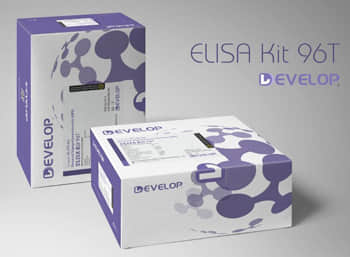Human Apelin (APLN) ELISA Kit


two product lines: Traditional ELISA Kit and Ready-to-Use ELISA Kit.
Other names:XNPEP2; APEL; APJ endogenous ligand
Function: Endogenous ligand for the apelin receptor (APLNR). Drives internalization of the apelin receptor (By similarity). Apelin-36 dissociates more hardly than (pyroglu)apelin-13 from APLNR (By similarity). Hormone involved in the regulation of cardiac precursor cell movements during gastrulation and heart morphogenesis (By similarity). Has an inhibitory effect on cytokine production in response to T-cell receptor/CD3 cross-linking; the oral intake of apelin in the colostrum and the milk might therefore modulate immune responses in neonates (By similarity). Plays a role in early coronary blood vessels formation (By similarity). Mediates myocardial contractility in an ERK1/2-dependent manner (By similarity). May also have a role in the central control of body fluid homeostasis by influencing vasopressin release and drinking behavior (By similarity).
Sequence:50 MNLRLCVQAL LLLWLSLTAV CGGSLMPLPD GNGLEDGNVR HLVQPRGSRN 70 GPGPWQGGRR KFRRQRPRLS HKGPMPF
INTENDED USE
The kit is a competitive inhibition enzyme immunoassay technique for the in vitro quantitative measurement of APLN in human serum, plasma or other biological fluids.
DETECTION RANGE
15.6-1000pg/mL. The standard curve concentrations used for the ELISA’s were 1000pg/mL, 500pg/mL, 250pg/mL, 125pg/mL, 62.5pg/mL, 31.2pg/mL, 15.6pg/mL.
SENSITIVITY
The minimum detectable dose of APLN is typically less than 6.13pg/mL.
The sensitivity of this assay, or Lower Limit of Detection (LLD) was defined as the lowest protein concentration that could be differentiated from zero. It was determined by adding two standard deviations to the mean optical density value of twenty zero standard replicates and calculating the corresponding concentration.
SPECIFICITY
This assay has high sensitivity and excellent specificity for detection of APLN.
No significant cross-reactivity or interference between APLN and analogues was observed.
You can reference link of the kit as following
https://dldevelop.com/Research-reagent/dl-apln-hu.html
https://dldevelop.com/Research-reagent/dl-apln-mu.html
https://dldevelop.com/Research-reagent/dl-apln-ra.html
Introduction
| Item | Standard | Test | |
| Description |
The kit is a competitive inhibition enzyme immunoassay technique for the in vitro quantitative measurement of APLN in human serum, plasma or other biological fluids. |
Conform | |
| Identification | Colorimetric | Positive | |
| Composition | Traditional ELISA Kit | Ready-to-Use ELISA KIT | Conform |
| Pre-coated, ready to use 96-well strip plate 1 | Pre-coated, ready to use 96-well strip plate 1 | ||
| Plate sealer for 96 wells 2 | Plate sealer for 96 wells 2 | ||
| Standard 2 | Standard 2 | ||
| Diluents buffer 1×45mL | Standard Diluent 1×20mL | ||
| Detection Reagent A 1×120μL | Detection Solution A 1×12mL | ||
| Detection Reagent B 1×120μL | Detection Solution B 1×12mL | ||
| TMB Substrate 1×9mL | TMB Substrate 1×9mL | ||
| Stop Solution 1×6mL | Stop Solution 1×6mL | ||
| Wash Buffer (30 × concentrate) 1×20mL | Wash Buffer (30 × concentrate) 1×20mL | ||
| Instruction manual 1 | Instruction manual 1 | ||
Test principle
This assay employs the competitive inhibition enzyme immunoassay technique. A monoclonal antibody specific to the index has been pre-coated onto a microplate. A competitive inhibition reaction is launched between biotin labeled the index and unlabeled the index (Standards or samples) with the pre-coated antibody specific to the index. After incubation the unbound conjugate is washed off. Next, Avidin conjugated to Horseradish Peroxidase (HRP) is added to each microplate well and incubated. The amount of bound HRP conjugate is reverse proportional to the concentration of the index in the sample. After addition of the substrate solution, the intensity of color developed is reverse proportional to the concentration of the index in the sample.
Recovery
Matrices listed below were spiked with certain level of recombinant APLN and the recovery rates were calculated by comparing the measured value to the expected amount of the index in samples.
| Matrix | Recovery range (%) | Average(%) |
| serum(n=5) | 81-93 | 86 |
| EDTA plasma(n=5) | 80-97 | 88 |
| heparin plasma(n=5) | 90-101 | 95 |
Linearity
The linearity of the kit was assayed by testing samples spiked with appropriate concentration of the index and their serial dilutions. The results were demonstrated by the percentage of calculated concentration to the expected.
| Sample | 1:2 | 1:4 | 1:8 | 1:16 |
| serum(n=5) | 82-96% | 83-98% | 81-99% | 93-101% |
| EDTA plasma(n=5) | 88-101% | 86-95% | 90-102% | 80-93% |
| heparin plasma(n=5) | 80-91% | 82-90% | 95-104% | 79-95% |
Precision
Intra-assay Precision (Precision within an assay): 3 samples with low, middle and high level the index were tested 20 times on one plate, respectively.
Inter-assay Precision (Precision between assays): 3 samples with low, middle and high level the index were tested on 3 different plates, 8 replicates in each plate.
CV(%) = SD/meanX100
Intra-Assay: CV<10%
Inter-Assay: CV<12%
Stability
The stability of ELISA kit is determined by the loss rate of activity. The loss rate of this kit is less than 5% within the expiration date under appropriate storage condition.
Note:
To minimize unnecessary influences on the performance, operation procedures and lab conditions, especially room temperature, air humidity, and incubator temperatures should be strictly regulated. It is also strongly suggested that the whole assay is performed by the same experimenter from the beginning to the end.
Assay procedure summary
1. Prepare all reagents, samples and standards;
2. Add 50µL standard or sample to each well.
And then add 50µL prepared Detection Reagent A immediately.
Shake and mix. Incubate 1 hour at 37℃;
3. Aspirate and wash 3 times;
4. Add 100µL prepared Detection Reagent B. Incubate 1 hour at 37℃;
5. Aspirate and wash 5 times;
6. Add 90µL Substrate Solution. Incubate 15-25 minutes at 37℃;
7. Add 50µL Stop Solution. Read at 450 nm immediately.
Order or get a Quote
We will reply you within 24 hours!














